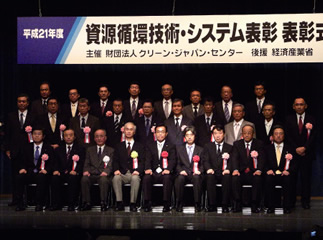Home > About Us > Sustainability Management > Sustainability Report > Sustainability Report 2010 > Resource Recycling Measures
 Resource Recycling Measures
Resource Recycling Measures
|
|
|
Curbing Waste Product Generation and Promoting Recycling
| In fiscal 2009, the Kobe Steel Group generated 4.5 million metric tons of byproducts, 98.7% of which was by the Iron and Steel Segment. Kobe Steel promotes the recycling of slag and dust generated as a byproduct of ironmaking. Beginning in fiscal 1992, Kobe Steel developed an action program targeting waste and has been promoting waste reduction and recycling on an ongoing basis. In fiscal 2009, the recycling rate was 92.8% for all Kobe Steel plants and 92.7% for the entire Group. In addition to taking steps to strengthen steel slag* quality control, we also managed to reduce the volume of waste sent to landfill during fiscal 2009 through initiatives such as switching to operating methods that do not use auxiliary materials containing fluorine, which impedes recycling. As we had to dispose of a certain amount of waste produced during the previous year as a result of activities such as plant construction work however, the Kobe Steel Group as a whole sent a total of approximately 300,000 metric tons of waste to landfill. In the years ahead, the Kobe Steel Group will steadily execute the voluntary action plans its industry associations, continue to develop recycling technologies, curb the generation of waste, and reduce the landfill volume. * Steel slag: Byproducts separated and recovered from metals melted during the refining process |
Byproduct Generation by Main Businesses (including Group companies)
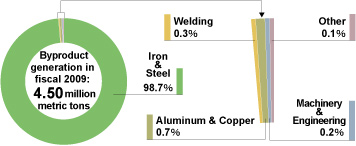
Amount of Byproduct Generated, Amount Recycled & Recycling Rate (Parent only)
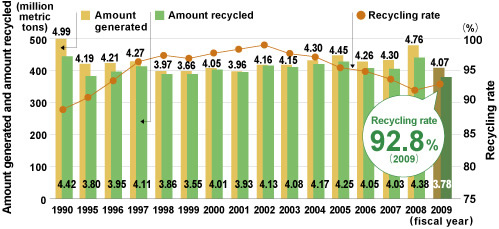
Voluntary Action Programs in Industry
|

Efforts Toward Becoming Zero-Emission Plants
| All plants and works have drawn up Action Programs to cut the quantity of waste sent to landfill and are continuing to increase reuse and recycling. |
Iron and Steel Sector
Recycling Byproducts| The Kakogawa Works has been running a zero-emission campaign to eliminate landfill disposal of wastes from the facility since 1997. The Works is continuing its efforts to achieving zero emission status by making effective use of used oil, sludge* etc., and by using dust as a raw material for making cement. A facility has been installed for recycling dust with high zinc content, which was previously difficult to treat. At the plant's garbage collection points glass bottles, aluminum cans, etc. are separated for recycling. |
Recycle Rate of Byproducts at the Kakogawa Works

* Sludge: Mud-like byproducts recovered as part of the process of treating industrial wastewater
Recycling steel slag
| Every year, the Kakogawa Works and Kobe Works together generate about 2.2 million metric tons of blast furnace slag and 900,000 metric tons of steelmaking slag as secondary products. This slag is reused as a raw material for cement production or as a bedding material in road construction. Compared with regular cement, blast furnace cement containing finely powdered blast furnace slag can limit the alkali-aggregate reaction. It also requires less energy consumption during production and reduces emissions of CO2, and is therefore popular in the market. Fine aggregate for concrete made of granulated blast furnace slag helps conserve natural resources by substituting for natural sand. By contrast, steelmaking slag can expand in volume owing to its free lime content, and so is used as a road bedding material after expansion has been stabilized through an accelerated ageing process that uses steam.Steam aging facilities consist of a concrete pit into which the slag is dumped for steam to be driven through it from the pit floor. Having increased the capacity of steam ageing facilities at both works, we are now able to process almost all of the steel slag that we produce. To enable end users to make the most of the properties of steel slag products and appropriately use them for their own purposes, we have formulated a Sales Management Manual, in accordance with the Nippon Slag Association's Guidelines on the Control of Iron and Steel Slag Products, as part of our steel slag production and sales operations. We use the manual for purposes such as quality control and checking on customers and the use of products and make every effort to control the production and sale of steel slag products. |
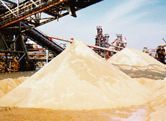 Granulated slag yard 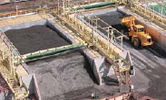 Steam aging facilities Steam aging facilities |
Recycling of Coal Ash
| The coal ash generated by coal-burning boilers is almost all used as a secondary resource either for cement-making or as a combination road bed material. At the Kakogawa Works, a pellet plant consisting of pelletizing and steam curing facilities has been installed to make use of fly ash. Almost all of the ash generated at the Works is processed and the pellets, called ash stone, are used for road-building. | 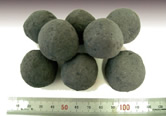 Pellets (ash stone) 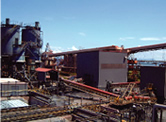 Pellet plant |
TopicsClean Japan Center Chairman's Prize
|
|||||||
Environmental restoration using steel slag
| In recent years, steel slag has been found to have restorative effects on marine environments, with iron, minerals and other nutrients contained within steel slag helping seaweed to flourish. As part of a steel slag-based environmental improvement model currently being developed in Hyogo prefecture by the Hyogo Ecotown Promotion Conference, the Kobe Steel Group started work on creating an artificial steel reef made from combining steel slag and steel in the waters around Nishishima, one of the Ieshima Islands, in July 2009. Although testing has only just got underway, with the aim of helping to grow seaweed and improve the fishing environment, the project is nonetheless making good progress, with noticeable seaweed growth and fish activity in the space of just half a year since the reef was completed. | 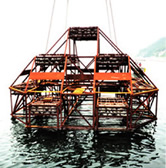 Test facilities 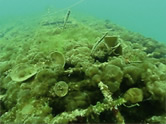 The artificial steel reef in the sea |
Welding Company
| The Welding Company continues to recycle waste oil into recycled oil and sludge for bedding material in road construction, recycle scrap wood from discarded pallets into chipboard materials, and recycle scrap steel into raw material for steel powder. We are also continually looking to increase the reuse of other valuable materials as we make every effort to reduce waste and increase our rate of recycling. Waste plastics are reduced in volume and then undergo thermal recycling at our works. We are also working to reduce cardboard packaging by wrapping welding materials in plastic for shipping as products. |
Aluminum and Copper Company
| The Moka Plant has installed two melting furnaces for scrap, improved the yield ratio during melting, and reduced the volume of impurities (aluminum dross) during aluminum melting. The plant also operates two arc furnaces to improve the recovery rate of aluminum dross. As a result of its R&D efforts, the remaining ash is effectively recycled as cement material. Most of the residual from aluminum dross is no longer disposed as landfill, resulting in a recycling rate of 93.2% in fiscal 2009. Also, the bricks and debris generated from furnace repairs are precisely sorted by machine to be recycled as road bed material. At the Chofu Works, an arc furnace is in operation for recovering aluminum dross and efforts have been made to recycle copper sludge, a material that was previously difficult to deal with. As in fiscal 2008, the recycling rate for fiscal 2009 is 99% or higher. At the Daian Plant, casting sand is either fed back into recycling machines and reused onsite or recycled into cement materials. |
Machinery and Engineering Company
| All byproducts generated at the plants are carefully sorted for recycling, either as recycled resources or as a heat source in cement production. Other initiatives include promoting the use of steel or plastic returnable containers for shipping some of our products and reusing cushioning materials from packaging.At the Harima Plant all industrial waste material is now turned into new resources. |
Group Companies
| Group companies are working to separate waste, reuse resources and recycle to reduce volumes of industrial waste for landfill disposal. |
Examples of Measures Taken (Japan)
|

